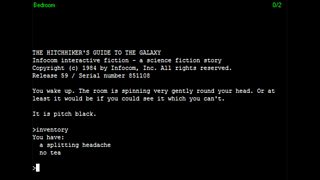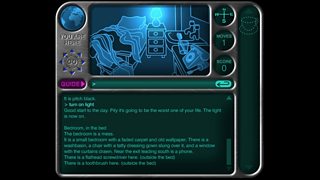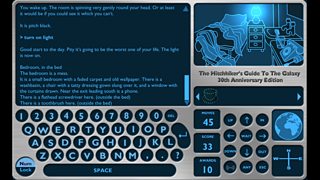About the game
The original game
"There was a time when computer games didn't have graphics. Or at least they couldn't have graphics and sound at the same time. They certainly couldn't have graphics, sound and enough content to keep even a human being amused for more than a few minutes. So they had text.

This was radical - a computer game you could control by typing in commands. The game would then respond to your commands with a breathtakingly prescient understanding of your intent. Or not. Usually not - the early text parsers (circa 1977) weren't that bright. But, as long as you limited yourself to what the game understood and the game designers wrote creatively enough to misunderstand you in a humorous and entertaining fashion, it all worked.
It therefore stands to reason that any game which combined a really good programmer with a really good writer was likely to do well. So when Steve Meretzky of Infocom got together with Douglas Adams to create a game based around the Hitchhiker's Guide to the Galaxy, the result was never going to be less than interesting and more than likely insane. So it proved - the Hitchhiker's Guide adventure game was one of the best-selling games of its era, selling some 350,000 copies. In 1984.
Then graphics games came along and the computer using portion of the human race forgot all about 500,000 years of language evolution and went straight back to the electronic equivalent of banging rocks together - the point'n'click game. Infocom and most of its competitors went to the wall - signalling the arrival of the post-literate society.
But something strange has now happened. The internet has become an integral part of millions of lives. People have learned to type again and are taking an interest in interacting, via their computers, with other people and with content."
Originally written for DouglasAdams.com by Richard Harris
The 20th anniversary edition
The 20th anniversary edition was still essentially a text game. The Infocom origins of the game were still evident, from the opening credits to the 'Help' message. . It was not an attempt to produce a fully animated version, the graphics as followed in the tradition of E. H. Shepard's illustrations for A.A. Milne's books - they didn't reflect all the events described. Most of the images rightly remained, to quote Simon Jones, "in the universe of your head."

The game was put together by a 4 person team, with Rod Lord supplying design brilliance, Sean Sollé the brains behind the game code, Roger Philbrick designing and coding the entire supporting site, and Shimon Young coding the Flash front end to create the lovely looking final product. For small team, their efforts made a big impact, and not only raised the traffic to the Radio 4 website by 1000%, but also scooped a BAFTA.
Despite its runaway success, in later years the game had been left to languish on some mothballed pages on a server that was due for demolition to make way for a high speed server array…
The 30th anniversary edition
The game was spotted languishing on these pages, quietly ticking over with up to 70 visitors on a good day. The time seemed right for a spit and polish and to re-house it on a shiny new server just before the old ones were switched off for good. An already cantankerous game with a penchant for killing people in a variety of amusing ways, the game has not become more friendly while sulking unloved and unnoticed.

The game is still the same wonderful piece of interactive fiction that Douglas Adams wrote and Steve Meretzky programmed, but in finding it a new home, a few changes needed to be made. The old Flash game would not work on the new servers, and in porting it to a new HTML5 incarnation, several innovations took place. We were able to build in a larger, handier interface, with additional keys and functionality, and build in the ability to tweet from the game.
Then things started to get silly. Having covered the basics, we decided to slip in an ‘Any’ key, just because we could. The $, % and ^ symbols were replaced with new ones for the Altarian Dollar, Flanian Pobble Bead and the Triganic Pu, not because they are needed in the game, but just because we felt like it. We then decided that rather than having a simple functionality where the user could tweet, we would allow the game itself to tweet, based on the actions of users in the game.
This was when the game's personality started to shine through. This may or may not prove to have been a good idea…



